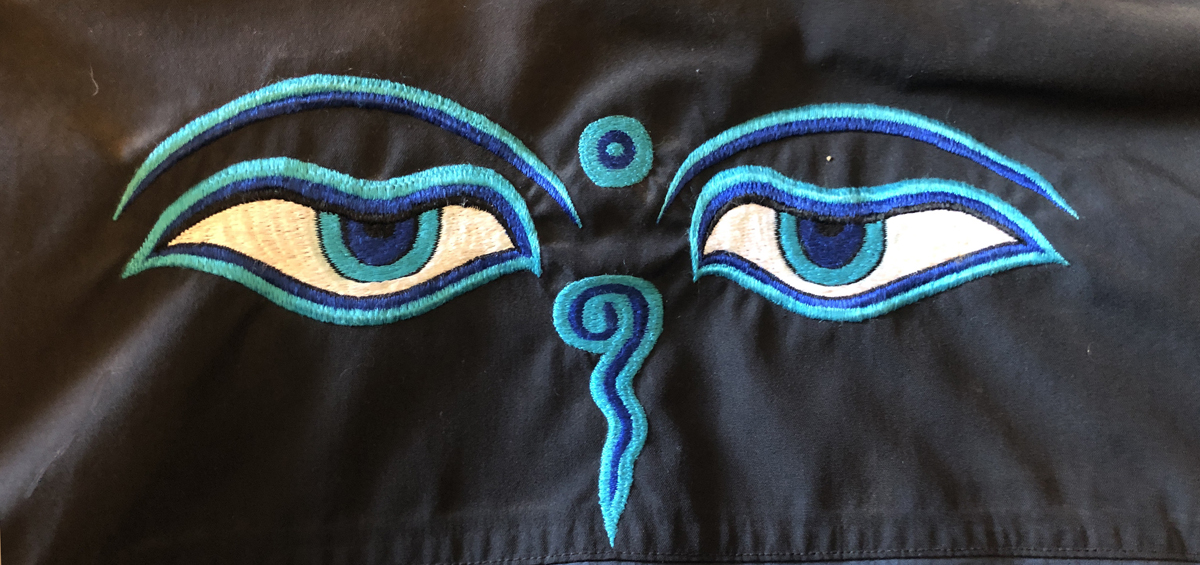
Buddha Eyes
Buddha Eyes embroidered on a North Face parka.
September 26, 1998 We had arrived in Nepal on the third day of the ten-day Hindu Daishan Festival, this year September 21 to October 4. It is the festival for the Goddess Durga that recounts her primordial battle with Mahishasura, a demon of manifest evil. It's a time of gatherings and feasts with extended family, including gift-giving, and getting new clothes. "Like your Christmas," Lokendra would tell us, "except they cut off the heads of many buffalo to celebrate". We didn't see any of that kind of Daishan spectacle, but it was probably on a particularly auspicious day that we crossed paths with the King of Nepal in Durbar Square.
We had three days to spend in Kathmandu, and Carol had several missions to accomplish. One was to find and acquire a certain list of Ayurvedic medicines to take back to an ailing friend in a California. A second goal was to find and purchase some tankhas, intricate hand-painted meditative mandalas, from someone in the Exiled Tibetan Buddhist community. A third involved getting some embroidery done.
Carol's friend Christine in California made part of her living producing one-of-a-kind pillows with embroidered designs on them. She sent Carol off with a stack of one-foot square silk swatches of various colors and textures, each with a paper drawing of a geometric sort of mandala in colored pens. In Kathmandu, there are any number of small embroidery shops that will stitch whatever design or logo desired onto any article of cloth or patch of fabric, or baseball cap. Carol had the name and address of one Christine had done business with before. She was to deliver the swatches, negotiate the deal, and pick them up on the way out of Nepal in a month and a half.
Kathmandu has an ancient history and as we could see from the air, most of the older buildings were made of bricks and mortar and the city streets were mainly cobblestone if not dirt. Many of the temples and shrines are well over a thousand years old, decaying if not collapsing, and in a constant state of repair. Only major thoroughfares were paved; roadways leading to the palace, bus routes and the highways out of town.
September 27. "Namaste" is a universal word of greeting. Its literal meaning is "I bow to you". It's used in India and Nepal as a prosaic "hello" and "goodbye", but also with inflection and gesture it can connote respect and sincerity. Its deeper meaning reflects the Hindu notion of Atman: the self that is the self in all of us. In its spiritual sense Namaste becomes "The God in me bows to the God in you," a gesture of deep respect and equality.
So this is the word shared with each person whose eyes you meet walking the streets, or any waiter or shopkeeper encountered. So you hear it and say it all day long. You can say it casually, with feeling, or with the highest of meaning.
This country had a theme song, Resham Firiri. You would hear it everywhere, especially in tourist areas and any shop that sold the simple three-stringed Sarangi, carved from a single piece of wood and played with a bow, like a violin. Buskers with their Sarangis or Basuri flutes, hand off the simple ditty blending from street to street.
Originally a love song in Nepali, many versions of lyrics mock both trekkers and guides in English. The Nepali children's version of the lyrics are about a spider that dreams of flying. This country has a way of putting you into a blissful trance.
It was an easy walk from the Vajra Hotel to the Thamel, and we began to get accustomed to the layout of our surroundings. There was sort of a main drag that was lined with restaurants, bookstores, bars and shops serving tourists, trekkers and climbers. This roadway was paved, to keep the dust down and cater to the tourist/trekker trade that energizes this district. Walking into the Thamel in the early morning, we saw shopkeepers raising the rollup doors of their shops and emerging with a small bucket of water. They would sprinkle it on the ground and sweep the roadway, before rolling out what goods they will display to passersby. Smack in the middle of the district is the storied "Kathmandu Guest House" a traveler's nexus and jumping off place for treks, with many levels of inexpensive accommodations, from a communal style dormitory to private suites. Close by are the Pilgrim Bookstore and Northfield Cafe.
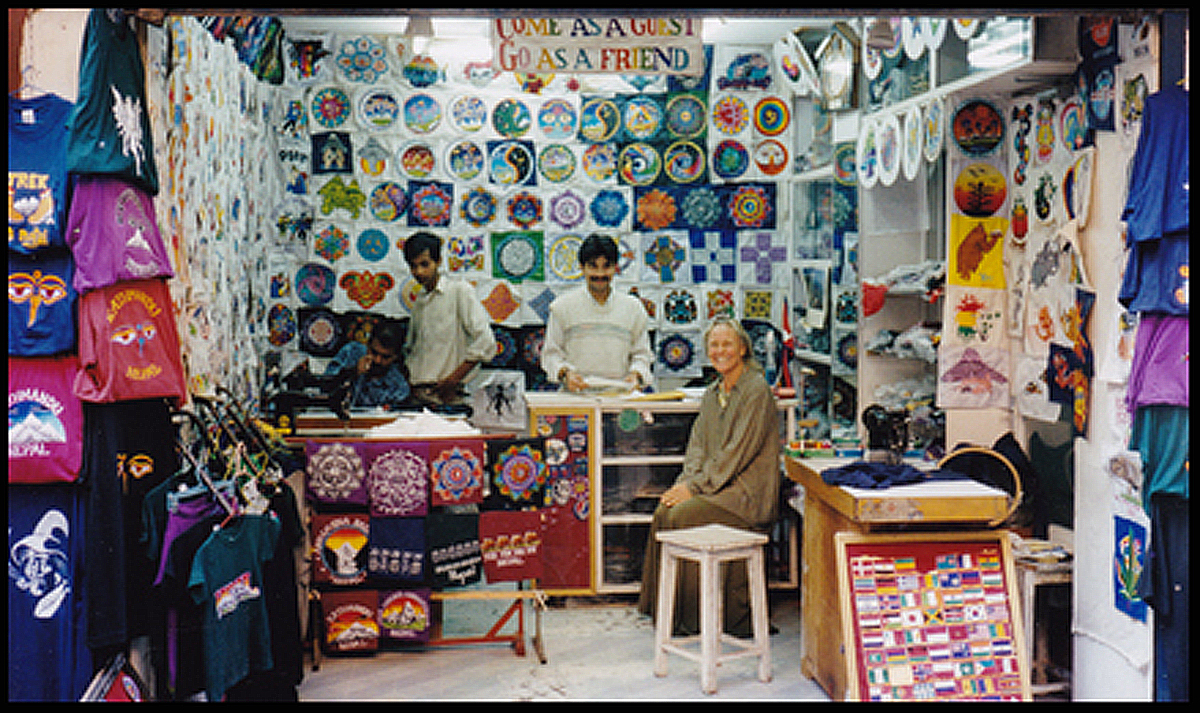
The embroiderer's shop was located a few steps off the main street into an alley that led to a cyber cafe, where you could send and receive emails, or rent some computer time to look something up on the internet. The shop was about 12 feet wide, open to the street. The front part was about 12 feet deep, then a curtained wall. Examples of their embroidery designs covered every surface. All kind of symbols and logos of religions and rock bands were rendered in bright colors. A single sewing machine was in the front of the shop, and I suppose there were more behind the curtain. An embroidered banner high on the back wall read: "Come as a guest, Go as a friend."
Nepal is 80% Hindu, 10% Buddhist, and 5% Muslim. The people in embroidery shop were Muslim, and a pleasure to interact with. The owner's name was Ostad, and in the style of Nepali meetings, stools were brought forth and one of his workers was sent around the corner to return with chai tea for all. He remembered Christine and was happy to receive the bundle. Carol unpacked her stack of swatches and designs. Everything was simple and clear. We would be leaving the country in six weeks. Then we began to have an unhurried conversation about everything; family, children, Nepal, America, the mountains.
Whenever Carol raised the topic of how much the embroidery would cost, he would say something like "You'll be very pleased with the price," and the conversation would wander off without getting around to saying what it was. We left that day after about an hour without ever hearing an answer.
September 28. The next day, we went back to the shop and continued our chat with Ostad. That day his brother Azum joined the tea and conversation. Azum had a jewelry business, but we weren't likely customers. He offered to show us around and arranged a car to take us up to the Swayambhunath Temple high above Kathmandu overlooking the city. It is the oldest stupa in the city, dating back to 460 AD. It has a very long 365-step staircase leading up to it, but the car and driver took us to the top so we could walk down. In 3 weeks time after our trek we were in such great shape that we skipped up the stairs, no problem. It's a classic Tibetan Buddhist Temple; a huge white dome with a large rectangular stupa with Buddha eyes facing each direction. Long strings of prayer flags strung from the stupa's finial fluttered and holy monkeys wandered about while sightseers looked out over the city.
In Nepal and Tibet, the tradition of prayer flags is very old. They are colors of the five elements: blue for sky or space; white for air or clouds; red for fire; green for water and yellow for earth. They are printed with Buddhist mantras and symbols to send prayers and blessings out to the world with each breeze or gust of wind.
At the center of a typical prayer flag is the image of a Wind Horse. At the Four corners of each are images of four sacred animals: a Garuda, a Dragon, a Tiger and a Snow Lion representing Wisdom, Strength, Confidence and Joy. Prayer flags fade and fray, left unhemmed for this purpose. The old ones are taken down and burned to release the last of their prayers to the wind.
September 29.
The next day we took a bus ride to another ancient Buddhist stupa, Boudhanath, about six miles from the Thamel in the eastern part of the city. Built in 760 AD by The Tibetan King Trisong Deutsen who ruled over Nepal at that time, it is the largest stupa in Nepal and the most important site in Tibetan Buddhism outside of Tibet. Similar to Swayambhunath with its big white dome, stupa with Buddha eyes. The strings of prayer flags dramatically radiating from the stupa are hundreds of feet long. It sits on a succession of massive platforms surrounded by a roughly circular wall that separates the temple complex from the maze of streets in the middle of the city.
Set into niches both inside and outside of that encompassing wall, were long banks of prayer wheels. A prayer wheel (also called a "mani wheel") is a cylinder of copper usually, embossed with Om Mani Padme Hum in Tibetan script. You pass them moving right to left, giving each a gentle spin, and so begins a cycle of prayer. Once again, like the prayer flags, the Tibetan Buddhists are employing devices to amplify and disperse their blessings. There will be more. Smaller portable prayer wheels are hand held with a little weighted bead on at small tether to help it spin.
After lunch in a balcony cafe that overlooked the Boudinath temple complex, we went back to the Thamel and looked in on Ostad and Azum. Again stools were brought out, tea was served and conversation continued. We would begin our trek in the morning, so this was the last visit before our trek. Still Ostad said, "I will take care of everything. You will be very happy with the price. Don't worry."
We spent 21 days trekking in the Himalayas with Lokendra, finishing our climb to Muktinath, returning to Jomson, and taking a plane ride back to Pokhara. We had only used 12 days of our 21-day contract with Lokendra, so he invited us to trek to his village. Two thirds of the way back to Kathmandu, we stopped and got off the bus. Next came an overcrowded bus from Kathmandu that was going to go off down a side road from the main highway, it was full, so we climbed up on roof with many others. The bus wound down a winding dirt road through the jungle with us clinging to the top until we got to the town of Dading, where we spent the night.
Now we were way off the beaten tourist track. The next morning came to the sound of Buddhist monks chanting in the room next door before dawn. We got on a bus that was taking a lot of girls to their school and this time we rode inside. The bus dropped the girls off at their destination and continued on through the jungle until we came to a dead end at a river.
A basket on a long cable transported us across the fast moving water. There was no vehicle traffic after that. By the end of the day we had reached Argut Bazaar and it was just a half day walk to Lokendra's home village of Baseri Odare, way, way off the beaten path. We spent two delightful days there and in the evening all the people of the village gathered and put on a show for us, singing and dancing. At the end of their performance they asked us if we could sing a song for them. We came up with "Old MacDonald Had a Farm", complete with sound effects. We were sent off the following day with great celebration; flower leis and red tikas on our foreheads.
Back in Kathmandu, Lokendra helped us find a large apartment near the Thamel with a view of the city in all directions. That's where we stayed, very inexpensively, for the rest of the weeks we were there. When we returned to Ostad's embroidery shop, he was the same as before and still would not discuss money with Carol. I had decided that I would get them to embroider some "Buddha Eyes" on the back of my North Face parka, which I wouldn't be needing in the city. Ostad took my jacket and assured me that he knew exactly what I wanted and that the price would be very reasonable. Like with Carol, he refused to talk further about money.
After another week in residence, everything in Kathmandu seemed familiar and even commonplace. Carol and I would take day trips around Kathmandu; to Durbar Square, Swayambuddinath again, up into the Nagarjun Forest to the top of Nagarjuna Hill, to Buddinath where the Buddha eyes on the enormous stupa are 10 feet tall and gaze out in the four directions. We took excursions to nearby towns of Bhaktapur, Patan and Nagarkot.
When in town Carol and I often went our separate ways. She had narrowed her search down to a particular shop and wanted to spend a lot of time examining the tankhas in minute detail.
One day when we were comparing notes about our separate adventures, we found that we had both come to the same conclusion about something we had never discussed. Everywhere in Kathmandu, there were people that had to beg to survive. Of course you have to say no or ignore most requests, because the needs are endless. But it hardens one to say no to all. Independently Carol and I had each decided to "adopt" one needy person to benefit the rest of our stay. Carol had picked an emaciated old woman who she encountered daily. I had chosen a leper, who had no legs and no fingers, and much of his face was gone. He lived on a small wooden platform with wheeled casters. I sought him out each day and pushed a small bill between the stubs of his fingers. I had decided he was going to have an extra good day the rest of the time I was in town, and on the last day, he got a bonus; the rest of the Nepali currency I would soon have no use for.
Finally, a few days before we were to depart, we went to the embroidery shop. The silk swatches were all done, beautifully. It came time to pay. When they told Carol what it was going to cost, we were both amazed at how cheaply it had been done. Carol had money left over from what she had been told to budget. Then Ostad brought out my jacket. You can see from the photograph how perfectly it was executed. The price...he gave it to me as a gift.
How can I put a price on that?
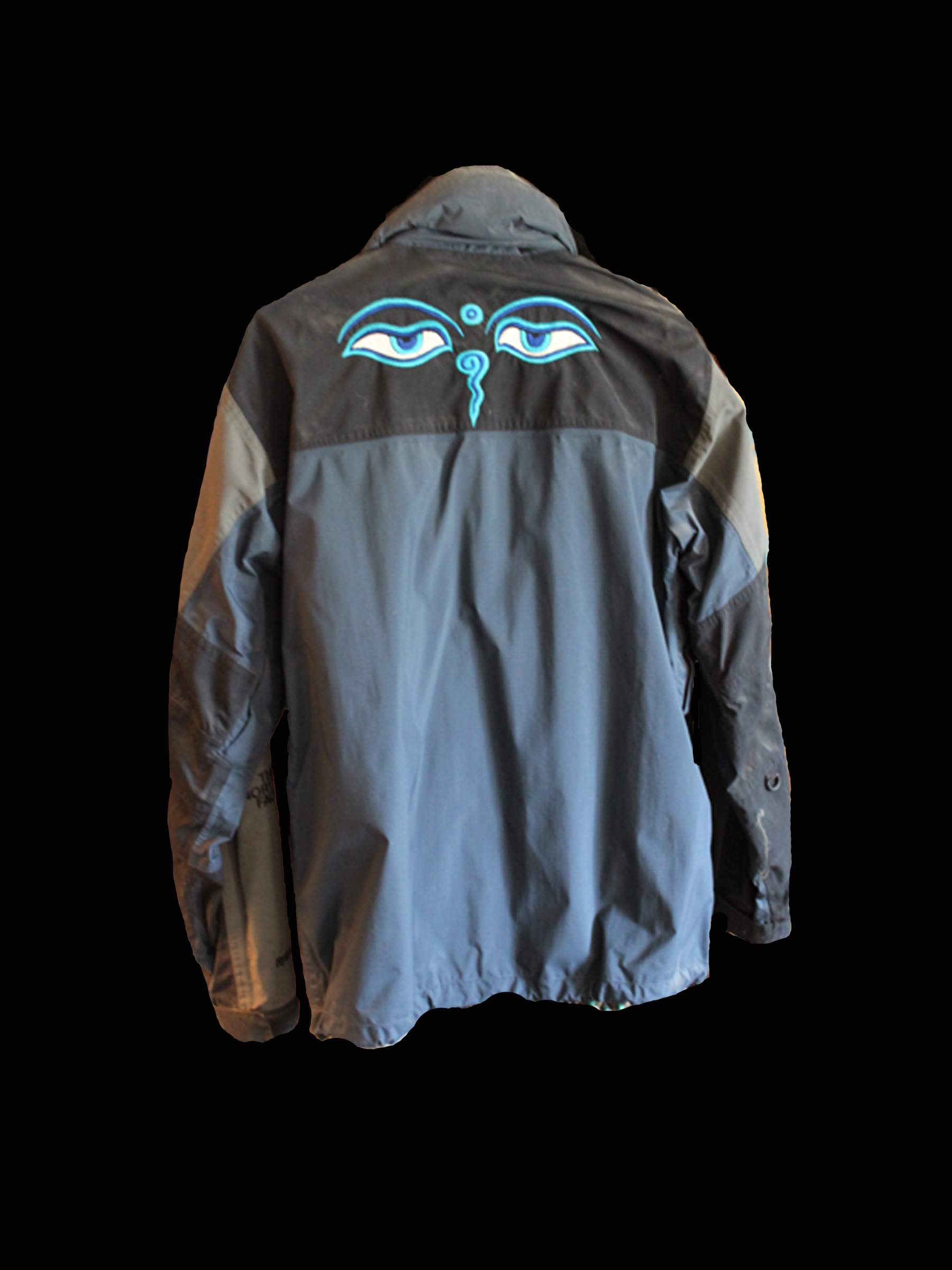
Not for sale. Uncle John's Garage Sale is just the name of the book.
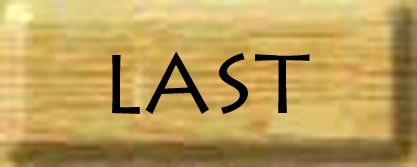

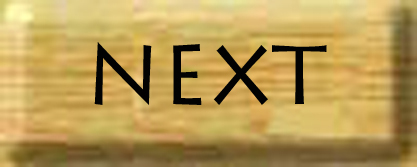
© 2022 John Oliver
All Rights Reserved
mail@unclejohnsweb.com

Buddha Eyes embroidered on a North Face parka.
September 26, 1998 We had arrived in Nepal on the third day of the ten-day Hindu Daishan Festival, this year September 21 to October 4. It is the festival for the Goddess Durga that recounts her primordial battle with Mahishasura, a demon of manifest evil. It's a time of gatherings and feasts with extended family, including gift-giving, and getting new clothes. "Like your Christmas," Lokendra would tell us, "except they cut off the heads of many buffalo to celebrate". We didn't see any of that kind of Daishan spectacle, but it was probably on a particularly auspicious day that we crossed paths with the King of Nepal in Durbar Square.
We had three days to spend in Kathmandu, and Carol had several missions to accomplish. One was to find and acquire a certain list of Ayurvedic medicines to take back to an ailing friend in a California. A second goal was to find and purchase some tankhas, intricate hand-painted meditative mandalas, from someone in the Exiled Tibetan Buddhist community. A third involved getting some embroidery done.
Carol's friend Christine in California made part of her living producing one-of-a-kind pillows with embroidered designs on them. She sent Carol off with a stack of one-foot square silk swatches of various colors and textures, each with a paper drawing of a geometric sort of mandala in colored pens. In Kathmandu, there are any number of small embroidery shops that will stitch whatever design or logo desired onto any article of cloth or patch of fabric, or baseball cap. Carol had the name and address of one Christine had done business with before. She was to deliver the swatches, negotiate the deal, and pick them up on the way out of Nepal in a month and a half.
Kathmandu has an ancient history and as we could see from the air, most of the older buildings were made of bricks and mortar and the city streets were mainly cobblestone if not dirt. Many of the temples and shrines are well over a thousand years old, decaying if not collapsing, and in a constant state of repair. Only major thoroughfares were paved; roadways leading to the palace, bus routes and the highways out of town.
September 27. "Namaste" is a universal word of greeting. Its literal meaning is "I bow to you". It's used in India and Nepal as a prosaic "hello" and "goodbye", but also with inflection and gesture it can connote respect and sincerity. Its deeper meaning reflects the Hindu notion of Atman: the self that is the self in all of us. In its spiritual sense Namaste becomes "The God in me bows to the God in you," a gesture of deep respect and equality. So this is the word shared with each person whose eyes you meet walking the streets, or any waiter or shopkeeper encountered. So you hear it and say it all day long. You can say it casually, with feeling, or with the highest of meaning.
This country had a theme song, Resham Firiri. You would hear it everywhere, especially in tourist areas and any shop that sold the simple three-stringed Sarangi, carved from a single piece of wood and played with a bow, like a violin. Buskers with their Sarangis or Basuri flutes, hand off the simple ditty blending from street to street.
Originally a love song in Nepali, many versions of lyrics mock both trekkers and guides in English. The Nepali children's version of the lyrics are about a spider that dreams of flying. This country has a way of putting you into a blissful trance.
It was an easy walk from the Vajra Hotel to the Thamel, and we began to get accustomed to the layout of our surroundings. There was sort of a main drag that was lined with restaurants, bookstores, bars and shops serving tourists, trekkers and climbers. This roadway was paved, to keep the dust down and cater to the tourist/trekker trade that energizes this district. Walking into the Thamel in the early morning, we saw shopkeepers raising the rollup doors of their shops and emerging with a small bucket of water. They would sprinkle it on the ground and sweep the roadway, before rolling out what goods they will display to passersby. Smack in the middle of the district is the storied "Kathmandu Guest House" a traveler's nexus and jumping off place for treks, with many levels of inexpensive accommodations, from a communal style dormitory to private suites. Close by are the Pilgrim Bookstore and Northfield Cafe.

Nepal is 80% Hindu, 10% Buddhist, and 5% Muslim. The people in embroidery shop were Muslim, and a pleasure to interact with. The owner's name was Ostad, and in the style of Nepali meetings, stools were brought forth and one of his workers was sent around the corner to return with chai tea for all. He remembered Christine and was happy to receive the bundle. Carol unpacked her stack of swatches and designs. Everything was simple and clear. We would be leaving the country in six weeks. Then we began to have an unhurried conversation about everything; family, children, Nepal, America, the mountains. Whenever Carol raised the topic of how much the embroidery would cost, he would say something like "You'll be very pleased with the price," and the conversation would wander off without getting around to saying what it was. We left that day after about an hour without ever hearing an answer.
September 28. The next day, we went back to the shop and continued our chat with Ostad. That day his brother Azum joined the tea and conversation. Azum had a jewelry business, but we weren't likely customers. He offered to show us around and arranged a car to take us up to the Swayambhunath Temple high above Kathmandu overlooking the city. It is the oldest stupa in the city, dating back to 460 AD. It has a very long 365-step staircase leading up to it, but the car and driver took us to the top so we could walk down. In 3 weeks time after our trek we were in such great shape that we skipped up the stairs, no problem. It's a classic Tibetan Buddhist Temple; a huge white dome with a large rectangular stupa with Buddha eyes facing each direction. Long strings of prayer flags strung from the stupa's finial fluttered and holy monkeys wandered about while sightseers looked out over the city.
In Nepal and Tibet, the tradition of prayer flags is very old. They are colors of the five elements: blue for sky or space; white for air or clouds; red for fire; green for water and yellow for earth. They are printed with Buddhist mantras and symbols to send prayers and blessings out to the world with each breeze or gust of wind.
At the center of a typical prayer flag is the image of a Wind Horse. At the Four corners of each are images of four sacred animals: a Garuda, a Dragon, a Tiger and a Snow Lion representing Wisdom, Strength, Confidence and Joy. Prayer flags fade and fray, left unhemmed for this purpose. The old ones are taken down and burned to release the last of their prayers to the wind.
September 29. The next day we took a bus ride to another ancient Buddhist stupa, Boudhanath, about six miles from the Thamel in the eastern part of the city. Built in 760 AD by The Tibetan King Trisong Deutsen who ruled over Nepal at that time, it is the largest stupa in Nepal and the most important site in Tibetan Buddhism outside of Tibet. Similar to Swayambhunath with its big white dome, stupa with Buddha eyes. The strings of prayer flags dramatically radiating from the stupa are hundreds of feet long. It sits on a succession of massive platforms surrounded by a roughly circular wall that separates the temple complex from the maze of streets in the middle of the city.
Set into niches both inside and outside of that encompassing wall, were long banks of prayer wheels. A prayer wheel (also called a "mani wheel") is a cylinder of copper usually, embossed with Om Mani Padme Hum in Tibetan script. You pass them moving right to left, giving each a gentle spin, and so begins a cycle of prayer. Once again, like the prayer flags, the Tibetan Buddhists are employing devices to amplify and disperse their blessings. There will be more. Smaller portable prayer wheels are hand held with a little weighted bead on at small tether to help it spin.
After lunch in a balcony cafe that overlooked the Boudinath temple complex, we went back to the Thamel and looked in on Ostad and Azum. Again stools were brought out, tea was served and conversation continued. We would begin our trek in the morning, so this was the last visit before our trek. Still Ostad said, "I will take care of everything. You will be very happy with the price. Don't worry."
We spent 21 days trekking in the Himalayas with Lokendra, finishing our climb to Muktinath, returning to Jomson, and taking a plane ride back to Pokhara. We had only used 12 days of our 21-day contract with Lokendra, so he invited us to trek to his village. Two thirds of the way back to Kathmandu, we stopped and got off the bus. Next came an overcrowded bus from Kathmandu that was going to go off down a side road from the main highway, it was full, so we climbed up on roof with many others. The bus wound down a winding dirt road through the jungle with us clinging to the top until we got to the town of Dading, where we spent the night.
Now we were way off the beaten tourist track. The next morning came to the sound of Buddhist monks chanting in the room next door before dawn. We got on a bus that was taking a lot of girls to their school and this time we rode inside. The bus dropped the girls off at their destination and continued on through the jungle until we came to a dead end at a river.
A basket on a long cable transported us across the fast moving water. There was no vehicle traffic after that. By the end of the day we had reached Argut Bazaar and it was just a half day walk to Lokendra's home village of Baseri Odare, way, way off the beaten path. We spent two delightful days there and in the evening all the people of the village gathered and put on a show for us, singing and dancing. At the end of their performance they asked us if we could sing a song for them. We came up with "Old MacDonald Had a Farm", complete with sound effects. We were sent off the following day with great celebration; flower leis and red tikas on our foreheads.
Back in Kathmandu, Lokendra helped us find a large apartment near the Thamel with a view of the city in all directions. That's where we stayed, very inexpensively, for the rest of the weeks we were there. When we returned to Ostad's embroidery shop, he was the same as before and still would not discuss money with Carol. I had decided that I would get them to embroider some "Buddha Eyes" on the back of my North Face parka, which I wouldn't be needing in the city. Ostad took my jacket and assured me that he knew exactly what I wanted and that the price would be very reasonable. Like with Carol, he refused to talk further about money.
After another week in residence, everything in Kathmandu seemed familiar and even commonplace. Carol and I would take day trips around Kathmandu; to Durbar Square, Swayambuddinath again, up into the Nagarjun Forest to the top of Nagarjuna Hill, to Buddinath where the Buddha eyes on the enormous stupa are 10 feet tall and gaze out in the four directions. We took excursions to nearby towns of Bhaktapur, Patan and Nagarkot.
When in town Carol and I often went our separate ways. She had narrowed her search down to a particular shop and wanted to spend a lot of time examining the tankhas in minute detail.
One day when we were comparing notes about our separate adventures, we found that we had both come to the same conclusion about something we had never discussed. Everywhere in Kathmandu, there were people that had to beg to survive. Of course you have to say no or ignore most requests, because the needs are endless. But it hardens one to say no to all. Independently Carol and I had each decided to "adopt" one needy person to benefit the rest of our stay. Carol had picked an emaciated old woman who she encountered daily. I had chosen a leper, who had no legs and no fingers, and much of his face was gone. He lived on a small wooden platform with wheeled casters. I sought him out each day and pushed a small bill between the stubs of his fingers. I had decided he was going to have an extra good day the rest of the time I was in town, and on the last day, he got a bonus; the rest of the Nepali currency I would soon have no use for.
Finally, a few days before we were to depart, we went to the embroidery shop. The silk swatches were all done, beautifully. It came time to pay. When they told Carol what it was going to cost, we were both amazed at how cheaply it had been done. Carol had money left over from what she had been told to budget. Then Ostad brought out my jacket. You can see from the photograph how perfectly it was executed. The price...he gave it to me as a gift.
How can I put a price on that?

Not for sale. Uncle John's Garage Sale is just the name of the book.



© 2022 John Oliver
All Rights Reserved
mail@unclejohnsweb.com

All Rights Reserved
mail@unclejohnsweb.com
